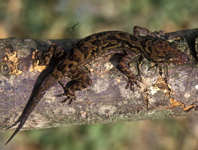State Key Laboratory of Genetic Resources and Evolution, and Yunnan Laboratory of Molecular Biology of Domestic Animals, Kunming Institute of Zoology, Chinese Academy of Sciences, 32 Jiaochang Donglu, Kunming 250223, Yunnan, China.
University of the Chinese Academy of Sciences, 19A Yuquan Road, Beijing 100049, China
Institute of Tropical Biology, Vietnam Academy of Science and Technology (VAST), 85 Tran Quoc Toan St., District 3, Ho Chi Minh City, Vietnam
Vietnam National University, Ho Chi Minh City, University of Science, 227 Nguyen Van Cu St., District 5, Ho Chi Minh City, Vietnam.
Vietnam National University, Ho Chi Minh City, University of Science, 227 Nguyen Van Cu St., District 5, Ho Chi Minh City, Vietnam.
Zoologisches Forschungsmuseum Alexander Koenig, Adenauerallee 160 53113 Bonn, Germany
Zoological Institute, Russian Academy of Sciences, Universitetskaya nab 1, St. Petersburg 199034, Russia
Centre for Biodiversity and Conservation Biology, Royal Ontario Museum, 100 Queen’s Park, Toronto, Canada M5S 2C6.
Centre for Biodiversity and Conservation Biology, Royal Ontario Museum, 100 Queen’s Park, Toronto, Canada M5S 2C6.
Vietnam National University, Ho Chi Minh City, University of Science, 227 Nguyen Van Cu St., District 5, Ho Chi Minh City, Vietnam.
State Key Laboratory of Genetic Resources and Evolution, and Yunnan Laboratory of Molecular Biology of Domestic Animals, Kunming Institute of Zoology, Chinese Academy of Sciences, 32 Jiaochang Donglu, Kunming 250223, Yunnan, China.
Hue University, College of Science, 77 Nguyen Hue St., Hue City, Vietnam.
Vietnam National Museum of Nature, VAST, 18 Hoang Quoc Viet St., Hanoi, Vietnam
Institute of Tropical Biology, Vietnam Academy of Science and Technology (VAST), 85 Tran Quoc Toan St., District 3, Ho Chi Minh City, Vietnam
State Key Laboratory of Genetic Resources and Evolution, and Yunnan Laboratory of Molecular Biology of Domestic Animals, Kunming Institute of Zoology, Chinese Academy of Sciences, 32 Jiaochang Donglu, Kunming 250223, Yunnan, China
State Key Laboratory of Genetic Resources and Evolution, and Yunnan Laboratory of Molecular Biology of Domestic Animals, Kunming Institute of Zoology, Chinese Academy of Sciences, 32 Jiaochang Donglu, Kunming 250223, Yunnan, China
Centre for Biodiversity and Conservation Biology, Royal Ontario Museum, 100 Queen’s Park, Toronto, Canada M5S
State Key Laboratory of Genetic Resources and Evolution, and Yunnan Laboratory of Molecular Biology of Domestic Animals, Kunming Institute of Zoology, Chinese Academy of Sciences, 32 Jiaochang Donglu, Kunming 250223, Yunnan, China.
Laboratory for Conservation and Utilization of Bio-resources, Yunnan University, 2 North Cuihu Road, Kunming 650091, Yunnan, China.

